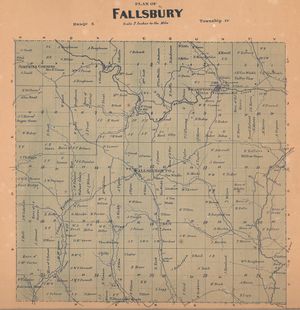Fallsbury Township
Fallsbury Township, in the extreme northeast corner of Licking County, was one of the last areas of the county settled by Europeans. Knox County and Coshocton Counties lie to the north of Fallsbury, Coshocton County to the east, Perry Township to the south and Eden Township to the west. The terrain in the township is hilly and rough in a manner similar to Eden Township, but with even less easily accessible farmland.
Unlike most parts of Licking County, Fallsbury has little surviving evidence of Native American mounds, earthworks, and enclosures. At the time of European settlement, accounts record the presence of groups of Shawnee encamping near the Wakatomika Creek in the township, but no significant structures left behind by Native Americans.
The first settler of European descent to settle in the township was David Bright, who built a cabin in 1818. The township was not organized until 1826, and indication of its rugged remoteness, but experience a period of population growth in the mid eighteenth century. [1] A small village sprang up near the center of the township and was called Fallsburg or Fallsbury. A post office was established in 1839, but was several times only to be reopened. I underwent its final closure in 1908. [2]. Another settlement, Frampton School, increased in size enough in the nineteenth century to warrant a post office, but this post office closed as well as the local population dwindled. [3] The villages, along with the township in general, had a population decline since the mid-nineteenth century. In 1850, the population numbered over twelve hundred. [4] The population of Fallsbury in the 2010 census was only 981. [5] The area remains rural and devoted to agriculture.
J.G.
Return to Townships and Communities main page.
References
- ↑ Brister, E., Centennial History, (1909), 280-282
- ↑ Ohio Ghost Towns: No. 44 Licking County, ed. Helwig and Helwig, (1998), 71
- ↑ Ohio Ghost Towns: No. 44 Licking County, ed. Helwig and Helwig, (1998), 74
- ↑ Brister, E., Centennial History, (1909), 280-284
- ↑ https://lickingcounty.gov/civicax/filebank/blobdload.aspx?BlobID=49096
